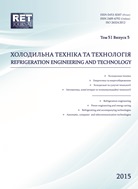COMPUTER SIMULATION OF A STIRLING REFRIGERATING MACHINE
DOI:
https://doi.org/10.15673/0453-8307.5/2015.39293Keywords:
Stirling refrigerating machine, Mathematical model, Dimensionless characteristics, Energy efficiency, HeliumAbstract
In present numerical research, the mathematical model for precise performance simulation and detailed behavior of Stirling refrigerating machine is considered. The mathematical model for alpha Stirling refrigerating machine with helium as the working fluid will be useful in optimization of these machines mechanical design. Complete non-linear mathematical model of the machine, including thermodynamics of helium, and heat transfer from the walls, as well as heat transfer and gas resistance in the regenerator is developed. Non-dimensional groups are derived, and the mathematical model is numerically solved. Important design parameters are varied and their effect on Stirling refrigerating machine performance determined. The simulation results of Stirling refrigerating machine which include heat transfer and coefficient of performance are presented.References
Gosney W. B. (1982), “Principles of Refrigeration”. Cambridge University Press, U. K.
McFarlane P., Semperlotti F., Sen M. (2013), “Mathematical model of an air-filled alpha Stirling refrigerator”. Journal of Applied Physics, No 114.
Wu F., Chen L., Wu C., Sun F. (1998), “Optimum performance of irreversible engine with imperfect regeneration”. Energy Conversion and Management, No 39(8), pp. 727-732.
Kaushik S.C., Kumar S. (2000), “Finite time thermodynamic analysis of endore-versible Stirling heat engine with regenerative losses”. Energy, No 25, pp. 989-1003.
V.S. Chakravarthy, R.K. Shah. (2011), “A review of refrigeration metods in the temperature range 4-300 k”. Journal of Thermal Science and Engineering Applications, No 3.
Thombare D.G. (2006), “Technological development in the Stirling cycle engines”. Renewable and Sustainable Energy Reviews, No 12, pp. 1-38.
A.T.A.M. de Waele. (2011), “Basic operation of cryocoolers and related thermal machines”. Journal of Low Temperature Physics, No 164, p. 179.
Tekin Y., Ataer O.E. (2010), “Performance of V-type Stirling-cycle refrigerator for different working fluids”. International Journal of Refrigeration, No 33, pp. 12-18.
Chen J., Yan Z. (1996), “The general performance characteristics of a Stirling refrigerator with regenerative losses”. Journal of Physics D: Applied Physics, No 29, pp. 987-990.
Erbay L.B., Yavuz H. (1997), “The maximum cooling density of a realistic Stirling refrigerator”. Journal of Physics D: Applied Physics, No 31.
Omari D. (1996), “Mathematical Modeling of Thermocompressive and Thermoacoustic Machines”. PhD thesis, University of Notre Dame, Department of Chemical Engineering. IN 46556.
McFarlane P., (2014), “Experiments with a presure-driven Stiling refrigerator with flexible chambers”. Journal of Applied Physics.


